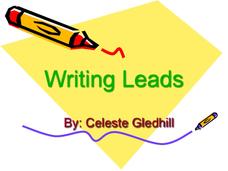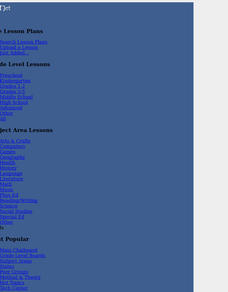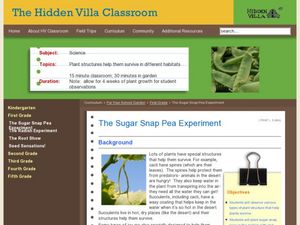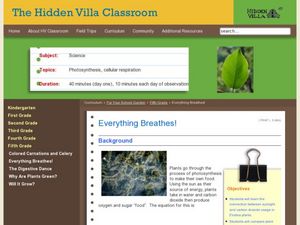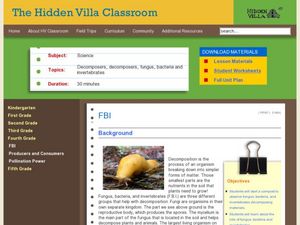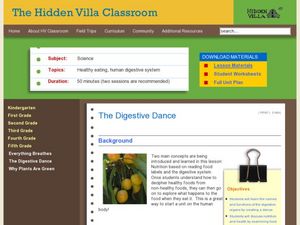iCivics
Step 9: Grab People’s Attention
Attention! Attention! Scholars investigate the concept of attention-grabbers in advertising a product or a cause. They use the ninth installment of a 10-part County Solutions - High School series to analyze t-shirts, bumper stickers,...
Curated OER
Writing Leads
Creative writing allows your students to explore their imagination and connect to literature in a personal way. This presentation will help you discuss what a good writing lead, or attention grabber is. Included are a list of lead types...
Santa Monica-Malibu Unified School District
Parts of Speech Adverbs: Building Blocks of Grammar
What is the difference between an adjective and an adverb? Encourages scholars to explore the answer to this question while building a foundation of the English language. The instructional activity comes complete with an attention...
Santa Monica-Malibu Unified School District
Parts of Speech Pre-Test: The Building Blocks of Grammar
Help your learners get a good grasp on grammar. An insightful pre-test allows teachers to learn about their young writers' knowledge of the building blocks of grammar, so they can begin building a unit of study. It includes a...
Curated OER
Round One: Where Are They?
Are you looking to engage your class with logic questions? Here is a simple activity in which learners use critical thinking skills to solve two questions. Use as a center activity or as a whole class attention-grabber.
Curated OER
Alphabet Book
Students create their own alphabet book using clip art in a publishing program. They are read Dr. Seuss's ABC by Dr. Seuss as an "attention grabber."
Curated OER
Introduction Paragraph
Key parts of an introductory paragraph (grabber sentence, connecting information, thesis) are highlighted in a presentation that uses color-coded sample paragraphs to illustrate how these parts combine to form a complete opening paragraph.
EngageNY
Building Background Knowledge: The Impending Fall of Saigon
Scholars read "Doc-Lap at Last" and participate in a Three Threes in a Row activity in which they answer three questions about the text in their rows. They then discuss the central idea of the text. Readers finish the lesson plan with a...
Curated OER
Give Me Five!
Students become familiar with their five senses and how their experiences would change without them. In this observations instructional activity, students observe using their five senses in a garden. Students illustrate what they've...
Curated OER
The Sugar Snap Pea Experiment
Students examine types of plant structure. In this plant biology lesson, students observe various types of plants, such as ivy and grapes, and discuss the differences in structure. Additionally, students plant sugar snap peas, using a...
Curated OER
Pollination Power
Second graders study and examine the structure of a flower. In this pollination lesson, 2nd graders observe pollinators in the garden and dissect a flower. Students then plant strawberry plants in the garden and observe the process of...
Curated OER
Food Chain
Fourth graders explore the concept of food chains. In this food chain lesson, 4th graders discuss what different animals eat and how they are all connected. Students explore a garden and the environment around them to find examples of a...
Curated OER
It's Just Dirt
Students discover how seed germination varies according to the soil type. For this soil science lesson, students discuss what plants need in order to grow and investigate various types of soil. Students use their senses to describe each...
Curated OER
Everything Breathes!
Fifth graders test plants in the dark and in the light to see which grows better and produces more carbon dioxide. In this plants lesson plan, 5th graders also create ways for plants to go through photosynthesis that they can observe.
Curated OER
Bird Brilliance!
First graders explore natural resources and search outdoors to find materials to create a bird's nest. In this bird's natural resources instructional activity, 1st graders listen to a book about birds and reflect on the various things...
Curated OER
FBI
Fourth graders experiment with compost. In this Science lesson, 4th graders begin a worm compost as well as an outdoor compost. Students discuss decomposition.
Southern Nevada Regional Professional Development Program
Common Core Writing Strand: The Research Paper Template for Standards 7-8
Considering a research paper for freshman and sophomores? Here's a template designed to meet the W.9-10.7 and 8 Common Core writing standards. Writers outline their research question, claims, counterarguments, support, commentary, and...
Virginia Department of Education
Maintaining Organization, Clarity, Central Idea, and Unity
Introduce and challenge the essay organization skills of your junior high writers with the paper reconstruction activity in this demonstration. Theydetermine what the word organization means, and discover the basic organizational...
Thomas Jefferson Foundation
Personal Morals vs. Political Moves Document Based Essay
Was Thomas Jefferson a hypocrite? Tackle this question with primary source analysis and an essay. The packet includes historical background, a writing prompt, a combined outline and checklist, and ten primary documents paired with...
Curated OER
Hippocratic Medical Rounds
A very interesting way to model Hippocrates allows your clas to to compare world views and to illustrate how ideas have changed at key times throughout the history of science. This simulation has students role play patients and physicians.
Curated OER
Six Plant Parts
Young scholars create a harvest burrito out of fruit, flowers, roots, stems, and more. In this plants lesson plan, students go out into the garden and identify the 6 plant parts.
Curated OER
Do They Grow Up or Down?
Students keep a garden journal after planting a garden and discuss environmental stresses put upon the garden for growth. In this garden lesson plan, students plant the plants differently from one another and observe the outcomes.
Curated OER
Living vs. Non-living
Students go on a nature walk and observe and discuss the living and non living things they see in the ecosystem. In this living and non living lesson plan, students complete a connecting string activity to simulate an ecosystem.
Curated OER
The Digestive Dance
Students read food labels to compare healthy verses non healthy food and then use diagrams to create a poster of the digestive system. In this food lesson plan, students move the food down the digestive track along the digestive system.



